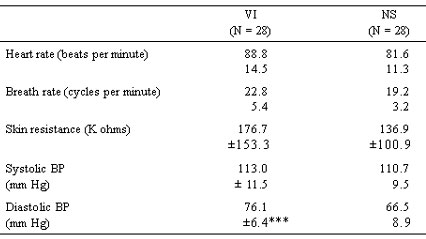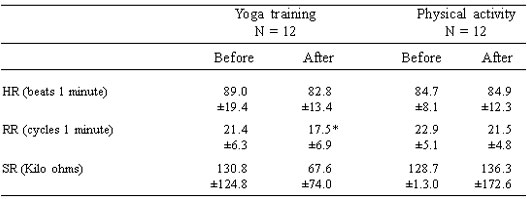|
DISCUSSION
The present study was carried out in two parts. The first part of the present study showed that children with impaired vision had higher diastolic blood pressure values, heart and breath rates, compared with normal sighted children of the same age. When the children with impaired vision were randomly assigned to yoga and physical activity (i.e., gardening groups), three weeks of yoga practice caused a reduction in the rate of breathing.
An increase in breath rate has been correlated With experimentally evoked fear and anxiety (Ax, 1953), as well as before situations such as parachute jumping (Fenz and Jones, 1972). The nature of waveforms recorded in a standard spirogram using a strain gauge transducer showed that there were different patterns as the immediate response to six selected emotions, including fear and anxiety (Bloch et al., 1991). These two emotions were found to be particularly likely to cause irregularity of breathing, with frequent periods of breath holding, whereas anger and sadness were found to produce regularly recurring abnormal patterns. Visual assessment of the records of the children with impaired vision and those with normal sight showed that the former had irregular breath cycles with frequent periods of breath holding. This may be due to higher levels of fear and anxiety in the visually impaired. This is in keeping with the report which described higher levels of fear (particularly related to physical injury) in the visually impaired (Ollendick et al., 1985). These subjects were possibly apprehensive as they were not familiar with the laboratory. In connection with this it may be noted that the subjects with normal sight were also visiting the laboratory for the first time. Also, equal efforts were made to reduce the apprehension of both groups by explaining the procedure in detail and answering their questions.
A low resting heart rate is an indicator of routine physical activity (Williams and Sperryn, 1962). Children with impaired vision were found to have poor physiological adjustment to exercise compared to their normal sighted counterparts (Hopkins et al., 1987). This was ascribed to an overall lower level of physical activity in these children. This explanation fiat a higher resting heart rate found in the children with impaired vision in the present study, could also apply to the higher (though not abnormally so) diastolic blood pressure values in the blind children.
In the second part of the study, the effect of two programs (yoga and increased physical activity during gardening) was assessed, using the same parameters as for the first part of the study. Previous reports have shown that yoga reduces psychophysiological signs of arousal (Wallace et al., 1971). The present results have shown that the yoga group showed a significant reduction in respiratory rate after three weeks of practice, while the group who were given gardening showed no change. The effects of yoga on the rate of respiration have been described in the previous literature. The practice of yoga reduces the breath rate, both as an immediate effect (Wallace et al., 197 1) and over a three month period (Joseph et al., 1981).
The present study showed that the practicing yoga for three weeks reduced the breath rate in children with impaired vision. Other known effects of yoga practice (e.g. a reduction in heart rate or an increase in skin resistance) were not observed. In fact, there was a non significant decrease in skin resistance following yoga, which could not be explained. It is possible that the duration of practice required to bring about a change in these parameters in the visually impaired is longer than in other individuals, as the latter have higher heart and breath rates and diastolic blood pressure values to begin with. These higher values may have been contributed to by the unfamiliar laboratory setting.
The practice of yoga modified the irregularity of breathing which was observed in the baseline assessment. These results are similar to the effects of yoga observed in community home children (Telles et al., 1997). As described earlier, an increase in breath rate was found to occur in response to fear, anxiety and other psychological stressors (Ax, 1953).
Hence the present results suggest that the visually impaired have higher levels of cardiac sympathetic activation and faster breathing than the normal sighted. A comparison of three weeks of yoga practice with a physical activity program showed that after the practice of yoga, the rate and irregularity of respiration was reduced. There were no other changes. Yoga techniques involve increased physical activity, with an emphasis on relaxation and awareness. This type of program appears to be useful to reduce irregularities in breathing which may be associated with anxiety, in the blind.
TABLE 1 : Autonomic measures in visually impaired (VI) and normal sighted (NS) children. Values are group mean ± SD  *P< 0.05 (1), * * P < 0.01 (2), *** P < 0.001 (2) Mann - Whitney U test,
"VI" versus "NS".
N = Number of subjects
TABLE II: (Yoga, physical activity) of children with impaired vision before and after the three week programs. Values are group mean ±SD  *p < 0.05 (2), Wilcoxone paired signed ranks test after versus before.
N = number of subjects
Acknowledgements
The authors are grateful to the staff and the children of the Raman Maharshi Academy for the Blind, Bangalore, India, for their enthusiastic participation in the study,
|